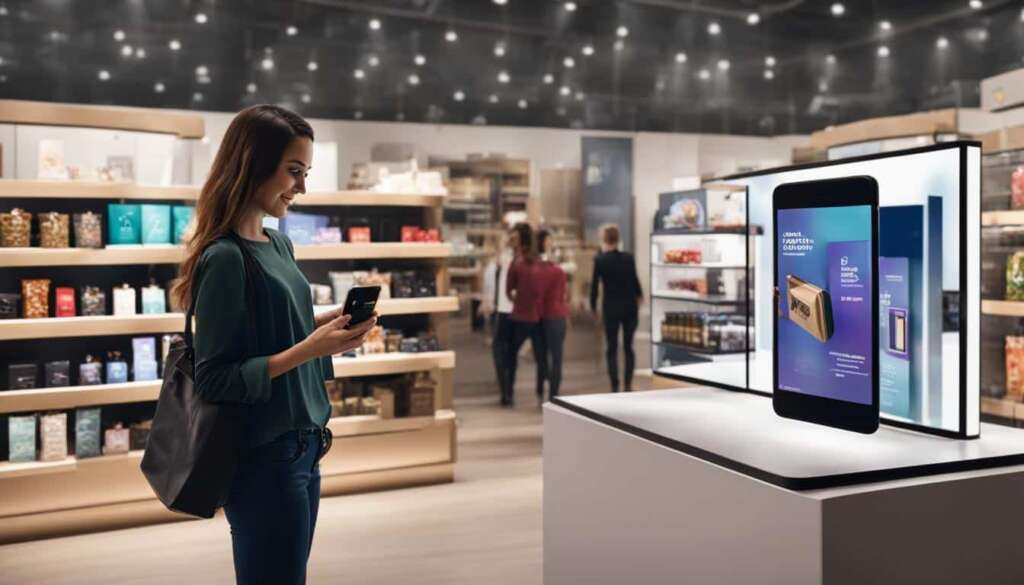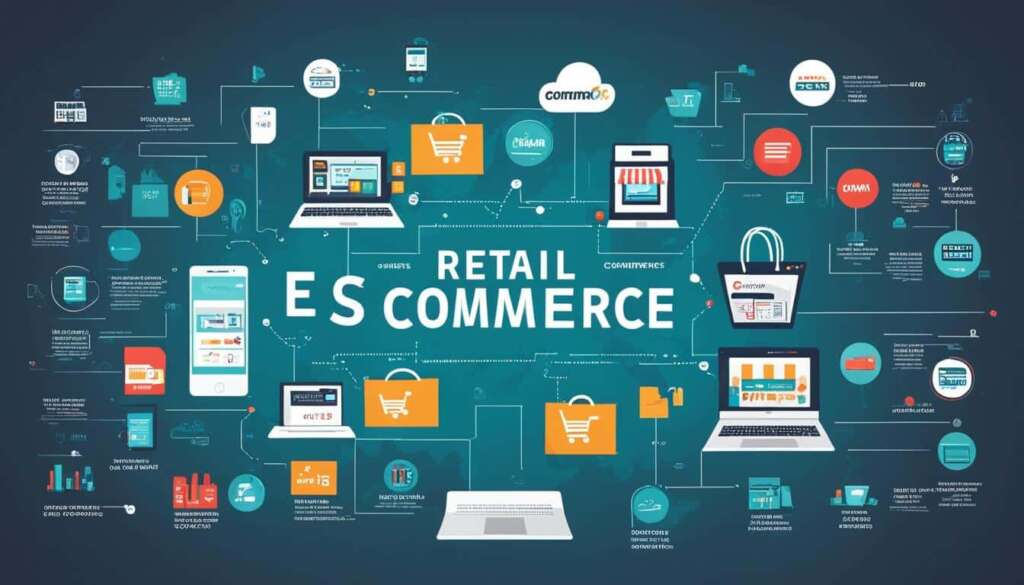Table of Contents
The e-commerce industry is witnessing rapid growth, with online retail becoming the preferred mode of shopping for consumers worldwide. As the digital marketplace expands, new technologies and innovations are transforming the way businesses operate and customers shop. In this article, we will explore the top e-commerce technology trends that are set to shape the industry in 2023.
With the aim of providing streamlined and personalized experiences, e-commerce platforms are increasingly leveraging cutting-edge technologies, such as artificial intelligence (AI) and machine learning (ML), augmented reality (AR) and virtual reality (VR), mobile commerce (m-commerce) with Progressive Web Apps (PWAs), voice commerce (v-commerce), and live-stream commerce.
Artificial Intelligence and Machine Learning in E-commerce
Artificial Intelligence (AI) and Machine Learning (ML) are revolutionizing the e-commerce industry by providing state-of-the-art technology solutions and automation capabilities. The implementation of AI and ML algorithms in various aspects of e-commerce has significantly enhanced efficiency and customer experiences.
AI-powered chatbots and intelligent virtual assistants
One of the key applications of AI in e-commerce is through the use of AI-powered chatbots and intelligent virtual assistants (IVAs). These intelligent bots enable businesses to offer instant and efficient customer support. By using natural language processing and machine learning algorithms, AI-powered chatbots can understand customer queries, provide real-time assistance, and even complete transactions. IVAs take customer support one step further by offering personalized recommendations and tailored experiences based on customer data analysis.
AI-powered chatbots and IVAs serve as virtual shopping assistants, guiding customers through their shopping journey, addressing their concerns, and assisting with purchase decisions. This technology not only improves the overall customer experience but also helps businesses scale their customer support operations.
Supply chain optimization and price optimization
AI and ML algorithms are transforming supply chain management in e-commerce by optimizing inventory management, demand forecasting, and logistics. These technologies analyze large volumes of data to identify patterns and trends, enabling businesses to optimize their inventory levels and reduce supply chain inefficiencies. By accurately predicting demand and streamlining logistics, companies can minimize stockouts, lower warehousing costs, and improve overall operational efficiency.
Price optimization is another area where AI and ML are making a significant impact. These technologies analyze market data, customer behavior, and competitor pricing strategies to dynamically adjust prices in real-time. By leveraging AI-powered price optimization solutions, businesses can maximize profitability while remaining competitive in a dynamic market.
Fraud detection and customer support
Fraud detection is a critical concern in e-commerce. AI and ML algorithms can identify suspicious patterns and anomalies in customer behavior, helping businesses detect and prevent fraud in real-time. By analyzing various data points and transaction patterns, AI-powered fraud detection systems can accurately flag fraudulent activities, protecting both businesses and customers from potential losses.
Customer support is another area that benefits greatly from AI and ML technologies. The use of AI-powered chatbots and IVAs streamlines customer support processes, reducing response times and increasing customer satisfaction. These virtual assistants can provide instant resolutions to frequently asked questions, handle simple queries, and escalate complex issues to human agents when necessary, ensuring efficient and personalized customer support.
Overall, AI and ML technologies are reshaping the e-commerce landscape by improving customer experiences, optimizing supply chain management, enhancing pricing strategies, detecting and preventing fraud, and streamlining customer support operations.
| Benefits of AI and ML in E-commerce |
|---|
| Enhanced customer experiences through personalized recommendations and tailored experiences |
| Optimized supply chain management, inventory management, and logistics |
| Dynamic price optimization for improved profitability and competitiveness |
| Real-time fraud detection and prevention |
| Efficient and scalable customer support with AI-powered chatbots and IVAs |
Augmented Reality and Virtual Reality in E-commerce
In the world of e-commerce, Augmented Reality (AR) and Virtual Reality (VR) are emerging as game-changing trends that are revolutionizing the way customers interact with products. AR and VR technologies provide immersive and interactive experiences, enhancing customer engagement and driving sales.
AR in e-commerce enables customers to virtually try on products, visualize them in real-life settings, and experience interactive product visualization. This technology allows customers to make more informed purchasing decisions by seeing how a product would look or fit before making a purchase. Virtual try-ons increase customer satisfaction and reduce return rates, resulting in cost savings for businesses.
Another exciting application of AR in e-commerce is the creation of virtual showrooms. These virtual spaces allow customers to explore and interact with products as if they were in a physical store. Virtual showrooms provide a unique shopping experience, combining the convenience of online shopping with the ability to see products up close.

On the other hand, VR in e-commerce transports customers into virtual environments where they can fully immerse themselves in the brand experience. VR technology enables businesses to create virtual events, offering customers the opportunity to attend product launches, fashion shows, or interactive brand experiences from the comfort of their own homes.
In addition to virtual events, VR can be utilized to create immersive shopping experiences. Customers can virtually walk through a virtual store, browse products, and make purchases, all within a virtual reality environment. This brings an exciting and interactive element to the online shopping experience, enhancing customer engagement and driving sales.
The ability to offer immersive product visualization, virtual try-ons, virtual showrooms, virtual events, and immersive shopping experiences sets e-commerce businesses apart from their competitors. AR and VR technologies make online shopping more compelling, interactive, and personalized.
Comparison of AR and VR in E-commerce
| Augmented Reality (AR) | Virtual Reality (VR) | |
|---|---|---|
| Definition | Augments the real world with virtual elements | Creates a fully immersive virtual environment |
| Applications | – Virtual try-ons – Interactive product visualization – Virtual showrooms – Real-life space visualization |
– Immersive brand experiences – Virtual events – Virtual shopping – Interactive product exploration |
| Customer Experience | Enhances product evaluation and decision-making Provides a realistic visualization of products in real-life settings Impressive interaction with products |
Immerses customers in virtual environments Creates memorable and interactive shopping experiences Increases customer engagement and brand loyalty |
| Technology | Overlays virtual elements onto a real-world environment through mobile devices or wearable devices | Requires VR headsets or devices that fully immerse the user in a virtual reality environment |
In summary, AR and VR are revolutionizing e-commerce by providing innovative ways for customers to interact with products and brands. From virtual try-ons and showrooms to immersive shopping experiences and virtual events, these technologies elevate the online shopping experience and drive customer engagement. Businesses that embrace AR and VR in their e-commerce strategies gain a competitive edge by offering unique and captivating experiences to their customers.
Mobile Commerce and Progressive Web Apps
Mobile commerce, or m-commerce, is experiencing significant growth as more consumers use their mobile devices for online shopping. To meet the demands of mobile users, businesses are turning to Progressive Web Apps (PWAs), which offer a native app-like experience on mobile devices.
PWAs are designed to enhance the mobile shopping experience, providing cross-platform compatibility, offline functionality, fast performance, and an app-like interface without the need for separate native apps. These apps can be accessed directly from a mobile browser, eliminating the need for users to download and install multiple apps for each retailer.
One of the key advantages of PWAs is their cross-platform compatibility, allowing them to work seamlessly across different operating systems and devices. Whether a customer is using an iOS or Android device, they can enjoy a consistent and optimized shopping experience.
Additionally, PWAs have offline functionality, enabling users to access and browse products even without an internet connection. This makes it easier for customers to shop while on the go or in areas with limited connectivity.
PWAs are also known for their fast performance, providing users with speedy loading times and smooth navigation. This ensures a seamless and efficient shopping experience, reducing the chances of customers abandoning their carts due to slow loading or lagging.
Furthermore, PWAs offer an app-like experience, complete with interactive features, push notifications, and the ability to add shortcuts to the home screen. This creates a more engaging and immersive shopping experience, similar to that of a native mobile app.
Overall, the adoption of PWAs in m-commerce is a growing trend that aligns with the evolving needs of mobile consumers. By leveraging cross-platform compatibility, offline functionality, fast performance, and an app-like experience, businesses can provide a seamless and optimized shopping experience for their customers.
Key Benefits of Progressive Web Apps in Mobile Commerce:
| Benefits | Description |
|---|---|
| Cross-platform compatibility | Provides a consistent experience across different operating systems and devices |
| Offline functionality | Allows browsing and shopping even without an internet connection |
| Fast performance | Offers quick loading times and smooth navigation |
| App-like experience | Delivers an immersive shopping experience with interactive features |
Voice Commerce
Voice commerce, or v-commerce, is an emerging trend in the e-commerce industry that leverages virtual assistants and smart devices to facilitate hands-free shopping. With the rise of virtual assistants like Amazon’s Alexa and Google Assistant, voice commerce offers a convenient and user-friendly shopping experience.
Virtual assistants are integrated into smart devices such as smartphones, smart speakers, and wearables, allowing users to interact with them through voice commands. These virtual assistants can assist with a wide range of tasks, including providing information, making recommendations, and even completing purchases on behalf of the user.
Voice commerce provides a convenient and accessible shopping experience for users of all abilities. By simply speaking to their virtual assistant, users can browse products, add items to their cart, and make secure payments without the need for manual interaction. This hands-free approach to shopping is particularly beneficial for individuals with physical disabilities or those who prefer a more convenient and streamlined shopping experience.
One of the key advantages of voice commerce is its seamless integration with virtual assistants. Virtual assistants are becoming increasingly intelligent and capable of understanding natural language, allowing users to interact with them in a more conversational manner. This integration enables virtual assistants to learn about users’ preferences and make personalized recommendations, enhancing the overall shopping experience.
Voice commerce is also shaping the future of e-commerce by enabling businesses to reach customers through new channels. As voice-enabled devices become more prevalent in households, retailers have the opportunity to deliver targeted promotions and engage with customers directly through virtual assistants. This opens up new possibilities for marketing and customer engagement, creating a more personalized and immersive shopping experience.
In conclusion, voice commerce is revolutionizing the way we shop online by providing a hands-free and convenient shopping experience. With the integration of virtual assistants and the advancements in voice recognition technology, customers can now interact with e-commerce platforms and complete transactions through natural language. As voice commerce continues to evolve, it is expected to play a significant role in the future of e-commerce, offering enhanced accessibility and a more personalized shopping experience.

Voice Commerce Trends
Voice commerce is a rapidly evolving field with several emerging trends. These include:
- Increasing adoption of voice assistants in e-commerce
- Integration of voice commerce with mobile apps and websites
- Expansion of voice commerce into new industries and sectors
- Improved voice recognition technology for more accurate interactions
- Integration of voice commerce with other emerging technologies like augmented reality
These trends are driving the growth of voice commerce and are expected to shape the future of online shopping.
Live-Stream Commerce
Live-stream commerce is a rapidly growing trend in e-commerce that is reshaping the way businesses showcase and sell products. By leveraging live-streaming platforms, such as Twitch, YouTube, and TikTok, retailers can engage with their audience in real time and create interactive shopping experiences.
One of the key advantages of live-stream commerce is the ability to showcase products in real-time, allowing customers to see how they look and function before making a purchase. This real-time product showcasing builds trust and boosts customer confidence, reducing the need for returns and increasing customer satisfaction.
Moreover, live-stream commerce goes beyond traditional e-commerce by integrating elements of entertainment. Retailers have tapped into the power of influencer marketing, partnering with popular social media personalities to host live-stream shopping events. These events not only entertain the audience but also create a sense of urgency and exclusivity, driving sales and increasing brand awareness.
Integration with social media platforms is another crucial aspect of live-stream commerce. Retailers can leverage the vast user base of platforms like Facebook and Instagram to expand the reach of their live-streams. By broadcasting their streams on these platforms, businesses can engage with a wider audience, attract new customers, and build a loyal community.
Ultimately, live-stream commerce offers a unique and immersive shopping experience that combines the convenience of e-commerce with the entertainment value of live videos. It allows customers to interact with retailers, ask questions, and get immediate feedback, fostering a sense of personal connection. With its real-time product showcasing, interactive nature, and social media integration, live-stream commerce is poised to transform the future of e-commerce.
Next, let’s explore the crucial role of sustainability and ethical shopping in the e-commerce industry.
Sustainability and Ethical Shopping
Consumers are increasingly conscious of the environmental and social impact of their purchasing decisions. This heightened awareness has given rise to sustainable shopping and ethical practices in the e-commerce industry. In 2023, retailers are expected to place a greater emphasis on sustainable sourcing, packaging, manufacturing, and initiatives aimed at reducing their carbon footprint. Additionally, ethical shopping practices that prioritize fair trade and social responsibility will continue to gain traction.
The Impact of Sustainable Shopping
Sustainable shopping involves making conscious decisions to support products and brands that prioritize eco-friendly practices and social responsibility. By opting for sustainably sourced and manufactured products, consumers contribute to the preservation of natural resources and promote a healthier environment. Ethical shopping, on the other hand, prioritizes fair trade, ensuring that workers involved in the production process receive fair wages and safe working conditions.
“Sustainable shopping is no longer a niche market. It’s a growing movement driven by consumers who demand transparency and accountability from brands. Retailers need to adapt to this shift by embracing eco-friendly practices and integrating social responsibility into their business models.” – Jane Smith, Founder of GreenLiving
Reducing the Carbon Footprint
One of the key focuses of sustainability in e-commerce is the reduction of carbon footprints. Retailers are increasingly implementing strategies to minimize the environmental impact of their operations and supply chains. This includes adopting renewable energy sources, optimizing transportation and logistics to reduce emissions, and implementing sustainable packaging solutions. By actively reducing their carbon footprints, retailers not only contribute to combatting climate change but also align themselves with consumer preferences for environmentally conscious brands.
Embracing Social Responsibility
Social responsibility is another important aspect of ethical shopping. Consumers are increasingly interested in supporting brands that prioritize fair trade, labor rights, and community engagement. Ethical retailers ensure that workers involved in the production process are provided with fair wages, safe working conditions, and other benefits. They also actively engage with and contribute to local communities, uplifting marginalized groups and fostering positive social change.
| Sustainable Shopping Practices | Eco-Friendly Initiatives |
|---|---|
| Source products from sustainable and eco-friendly suppliers | Switching to renewable energy sources |
| Reduce single-use packaging and promote reusable alternatives | Optimize transportation to reduce carbon emissions |
| Support fair trade and ethical manufacturing practices | Implement sustainable packaging solutions |
| Promote transparency and supply chain traceability | Engage in community initiatives and social programs |
Sustainable shopping and ethical practices are no longer just trends; they are becoming integral components of the e-commerce landscape. Retailers that embrace sustainable initiatives and demonstrate social responsibility have the opportunity to attract a growing consumer base that prioritizes eco-friendly and ethical choices. By adopting these practices, businesses contribute to building a more sustainable future.
Conclusion
E-commerce is an industry that is continuously evolving, with technology playing a major role in shaping its future. In 2023, several key trends are expected to dominate the e-commerce landscape. These trends include the integration of artificial intelligence (AI) and machine learning (ML) to provide personalized customer experiences and optimize various aspects of online retail.
Additionally, augmented reality (AR) and virtual reality (VR) are set to transform the way customers interact with products, allowing them to virtually try on items and explore immersive shopping environments. Mobile commerce (m-commerce) with Progressive Web Apps (PWAs) will continue to gain popularity, offering fast and seamless shopping experiences across different devices.
Voice commerce (v-commerce) is another trend to watch, as virtual assistants become more sophisticated and enable hands-free shopping. Furthermore, live-stream commerce is on the rise, providing real-time product showcasing and interactive experiences through social media integration.
Lastly, sustainability and ethical shopping practices are becoming more important to consumers, driving retailers to adopt eco-friendly initiatives and reduce their carbon footprint. By embracing these e-commerce trends, businesses can enhance customer experiences, drive sales, and stay competitive in the digital marketplace.
FAQ
What are the top e-commerce technology trends for 2023?
The top e-commerce technology trends for 2023 include artificial intelligence (AI) and machine learning (ML), augmented reality (AR) and virtual reality (VR), mobile commerce (m-commerce) with Progressive Web Apps (PWAs), voice commerce (v-commerce), and live-stream commerce.
How is AI and ML revolutionizing the e-commerce industry?
AI and ML are revolutionizing the e-commerce industry by providing state-of-the-art technology solutions and automation capabilities. AI-powered chatbots and intelligent virtual assistants (IVAs) offer instant customer support, while AI-powered personalization analyzes customer data to provide personalized recommendations and tailored experiences. AI and ML also optimize supply chain management, pricing, and fraud detection in e-commerce.
What benefits do AR and VR bring to e-commerce?
AR and VR bring various benefits to e-commerce. AR allows customers to virtually try on products, visualize them in real-life spaces, and experience interactive product visualization. VR creates virtual environments for exploring and interacting with products and can be leveraged for virtual showrooms, virtual events, and immersive brand experiences in e-commerce.
How is mobile commerce evolving in 2023?
Mobile commerce, or m-commerce, is evolving in 2023 as more consumers use mobile devices for online shopping. To cater to mobile users, businesses are adopting Progressive Web Apps (PWAs) that provide a native app-like experience on mobile devices. PWAs offer cross-platform compatibility, offline functionality, fast performance, and an app-like experience without the need for separate native apps.
What is voice commerce, and how does it enhance the shopping experience?
Voice commerce, or v-commerce, leverages virtual assistants and smart devices for hands-free shopping. With the rise of virtual assistants like Amazon’s Alexa and Google Assistant, voice commerce offers a convenient and user-friendly shopping experience. Virtual assistants can assist with information, recommendations, and purchasing, making shopping accessible and inclusive.
What is live-stream commerce, and how does it integrate with social media?
Live-stream commerce is a growing trend in e-commerce where businesses use live-streaming platforms to showcase and sell products in real-time. This trend combines elements of entertainment and interactive shopping experiences. Live-stream commerce integrates with social media platforms like Facebook and Instagram, providing businesses with a wider audience reach and unique engagement opportunities.
How are sustainability and ethical shopping practices influencing e-commerce?
Consumers are increasingly conscious of the environmental and social impact of their purchasing decisions. This has led to the rise of sustainable and ethical shopping practices in e-commerce. In 2023, retailers are expected to focus more on sustainable sourcing, packaging, manufacturing, and initiatives to reduce their carbon footprint. Ethical shopping practices that consider fair trade and social responsibility will also continue to gain traction.
Why is it important for businesses to stay ahead of e-commerce trends?
E-commerce is a rapidly evolving industry, and staying ahead of the trends is crucial for success. By leveraging the latest e-commerce technology trends, such as AI and ML, AR and VR, m-commerce with PWAs, v-commerce, and live-stream commerce, retailers can enhance customer experiences, increase sales, and stay competitive in the digital marketplace.













